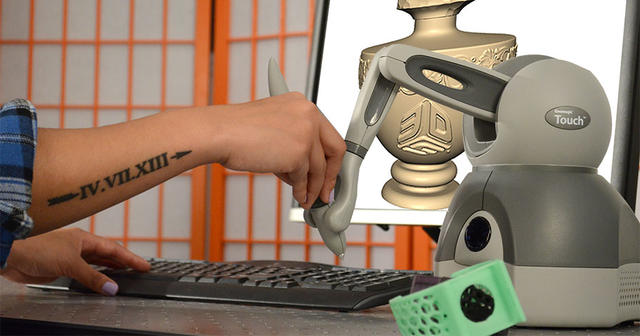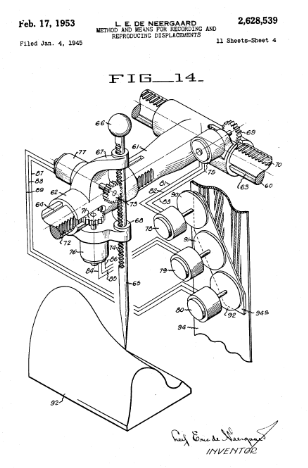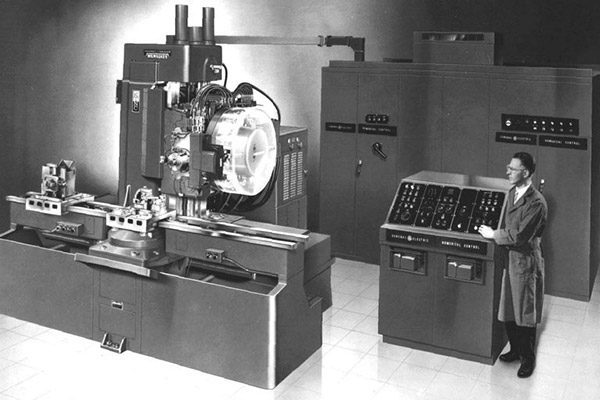In David Noble’s book, Forces of Production: A Social History of Industrial Automation, the late York University professor examined the history of machine tool automation in the U.S. Noble argues that computerized numerical control (CNC), was the result of social and political forces that pushed for greater automation in manufacturing so that large corporations, particularly those in the aerospace and weapons industries, could maintain leverage over union members on the factory floor.
While Noble makes his argument and relays the history of CNC, he touches briefly on a technology that has become otherwise lost from manufacturing history. Invented by Lloyd B. Sponaugle and Leif Eric de Neergaard at the end of World War Two, it was called “record-playback” or the “motional” method for programming machine tools.
How it worked was that a machine operator would fabricate a part or trace a template of the part and the system would record the operator’s motions onto magnetic or punched tape. The tape could then be fed into a piece of manufacturing equipment, like a lathe, and the motions would be replayed, just as the machine operator had performed them, producing an identical part.
The technology got far enough that multiple patents were filed for it and working systems were developed, including within GE, which sought machine tool automation due to a number of large strikes that had recently occurred at its Schenectady, New York headquarters. In 1946, two engineers from GE’s Industrial Control Division, Lowell Holmes and Lawrence Peaslee, followed in the footsteps of Leif Eric de Neergaard, “recording and reproducing displacements (registered as shifts in the phase of electrical signals).” The initial system featured a selsyn generator, with which the angular movement was transmitted to a motor that moved an odometer counter and a wire recorder.
To test the technology, the engineers were able to record the number of motor revolutions using the recording wire. The signal was then played back, performing the same number of revolutions. Using the recording wire, Holmes and Peaslee were only able to record one channel of data, leading them to test out magnetic tape as a recording medium. The pair modified a single-track audio recorder to include four tracks. At the time, tape recording was only in its nascent stages, leading the engineers to invent their own means of recording and reading the tape.
The next step involved recording the three-axis movement of a tracer stylus along a part template. Then, they were able to apply this technique to recording the motion of a machine tool being manually operated. By 1947, GE’s record-playback system was working, capable of recording a tracer stylus or a machine operator’s movements with accuracy of up to one-thousandth of an inch.
Holmes’s boss, Harry Palmer, saw the technology as a method by which the company could hire fewer skilled (more expensive) machinists, saying record-playback could be a “multiplier for the few outstanding machinists.” Kurt Vonnegut, who worked as a publicist for the company then, pointed out that it would also save time in training machinists.
However, according to Noble, because the record-playback “relied too heavily upon the skills of machinists (programs reflected their intelligence, their control) and hence fell far short of the ultimate goals of management and the fantasies of the technical enthusiasts.” Therefore, the technology was abandoned by companies like GE in favor of numerical control (N/C, later to become CNC).
Noble explains how N/C, instead of relying on the motions of the machine operator, the machine toolpaths were “described in detail mathematically, corresponding to the blueprint specifications for the part”. This was recorded in the form of numerical information onto magnetic or punched tape.
Record-playback allowed a human operator to interpret a blueprint and manually perform the manufacturing process. In contrast, N/C was an abstract method calculated by a “part programmer” who sat at a desk. Previously tactical fabrication was made into something algorithmic. Noble put it this way:
Whereas record-playback was a reproducer and, thus, a multiplier of skill, extending the reach of the machinist, N/C was an abstract synthesizer of skill, circumventing and eliminating altogether the need for the machinist. In short, as one early N/C inventor described it, N/C was an ‘automatic machinist.’
Though Noble argues that the end goal for management was to replace troublesome workers with reliable machines, he explains that management ultimately compromised with unions and gave union workers the ability to “patch” and write CNC programs.
In the end, the adoption of CNC may not have impacted the relationship between workers and their bosses overall, but one can only imagine what would have happened had record-playback become the dominant machining technology on the market.
CNC eventually enabled the development of 3D printing, with the same machine tool path methodology being used to program the route of 3D printers as they deposit material. In some cases, CNC systems are still modified to become 3D printers. Nobel also points out how the development of N/C codeveloped with computers. We can now see how mathematically derived geometries on computer screens are fabricated layer by layer on 3D printers. Interestingly, we also see GE playing a key role in the development of additive manufacturing.

The Touch from 3D Systems provides haptic feedback for virtual design. Image courtesy of 3D Systems.
Had record-playback dominated, it’s not out of the realm of possibility that computers and 3D printers might not still have been invented. They may have even evolved from a more tactile, intuitive perspective, rather than the abstract, cerebral methods of N/C. We might even imagine modern computers and design software being more user-friendly. Perhaps haptic styluses resembling 3D Systems’ Touch device, depth sensors like the Leap motion controller, or VR headsets would have been developed instead of the more indirect methods of interfacing with computers that we use today, such as keyboards and mice. Currently, we can train robots by moving their arms and then having them replay these movements so perhaps we’re going to for some applications return to a similar development?
Of course, those are only one person’s ideas of what may have happened had history not played out the way it had, but it does bring up an important point at the heart of Noble’s book: the trajectory of technology is not written in stone, but determined by social and political forces. As 3D printing continues to develop, we can think about how we might direct its evolution in ways that benefit the most people possible, rather than those seeking to control it for their own ends.
Join the discussion of this and other 3D printing topics at 3DPrintBoard.com.
Subscribe to Our Email Newsletter
Stay up-to-date on all the latest news from the 3D printing industry and receive information and offers from third party vendors.
You May Also Like
3D Printing News Briefs, April 27, 2024: Research, Digital Dentistry, Cycling, & More
We’re starting today’s 3D Printing News Briefs with some research into 3D printed luminescent quantum-dot polymer architectures and free-form laser beam shaping, and then on to an open source 4-axis...
HP & INDO-MIM Collaborate to Boost Metal 3D Printing in India
HP Inc. and INDO-MIM, a US- and India-based supplier of metal injection molding (MIM) powders and contract manufacturer, have announced that the two companies will collaborate to accelerate additive manufacturing...
3D Printing News Briefs, February 17, 2024: Shot Blasting, Service Bureaus, & More
In today’s 3D Printing News Briefs, we’re starting out with post-processing, as SKZ Würzburg is using a shot blast system from AM Solutions for its research. Moving on to business,...
3D Printing News Unpeeled: Not That Kind of Organ 3D Printing
GKN Aerospace will create a 150 jobs in Trollhattan Sweden with an investment of $60 million part of which comes from the Swedish Energy Agency’s Industriklivet initiative. The investment will...
































